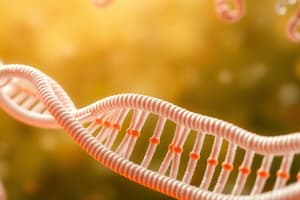Podcast
Questions and Answers
Where in the cell is the DNA found?
Where in the cell is the DNA found?
Nucleus
Where in the cell does transcription take place?
Where in the cell does transcription take place?
In the nucleus
What polymer is synthesized during transcription?
What polymer is synthesized during transcription?
pre-mRNA
What monomers are used to construct this polymer and where are they found?
What monomers are used to construct this polymer and where are they found?
What enzyme is required for transcription?
What enzyme is required for transcription?
What is the base-pair rule for a DNA strand matching an RNA strand?
What is the base-pair rule for a DNA strand matching an RNA strand?
Compare this base-pair rule with that of two DNA strands.
Compare this base-pair rule with that of two DNA strands.
Which strand of the DNA contains the 'blueprint' for the pre-mRNA?
Which strand of the DNA contains the 'blueprint' for the pre-mRNA?
In which direction is the DNA molecule read?
In which direction is the DNA molecule read?
In which direction is the pre-mRNA molecule constructed?
In which direction is the pre-mRNA molecule constructed?
Consider the definition of transcription and explain why the process in Model 1 is described using that word.
Consider the definition of transcription and explain why the process in Model 1 is described using that word.
What parts make up the transcription initiation complex?
What parts make up the transcription initiation complex?
Where on the DNA strand does the initiation complex form?
Where on the DNA strand does the initiation complex form?
Is it likely that a cell would transcribe all the genes within its nucleus simultaneously?
Is it likely that a cell would transcribe all the genes within its nucleus simultaneously?
Is it likely that all cells transcribe all their genes at some point in their lifetime?
Is it likely that all cells transcribe all their genes at some point in their lifetime?
What has been removed from the pre-mRNA to make it into mRNA?
What has been removed from the pre-mRNA to make it into mRNA?
What has been added to the mRNA that was not present in the pre-mRNA, and where on the mRNA strand are the additional items located?
What has been added to the mRNA that was not present in the pre-mRNA, and where on the mRNA strand are the additional items located?
Identify the structure through which the mRNA leaves the nucleus.
Identify the structure through which the mRNA leaves the nucleus.
What sequence of bases indicate the starting point for the polypeptide 'blueprint'?
What sequence of bases indicate the starting point for the polypeptide 'blueprint'?
Why is this molecule called messenger RNA?
Why is this molecule called messenger RNA?
The human genome contains about 25,000 genes and yet produces about 100,000 different polypeptides. Propose an explanation of how this is possible.
The human genome contains about 25,000 genes and yet produces about 100,000 different polypeptides. Propose an explanation of how this is possible.
Develop a hypothesis to explain the advantage of a poly-A tail added to the 3' end of the mRNA.
Develop a hypothesis to explain the advantage of a poly-A tail added to the 3' end of the mRNA.
Considering the purpose of adding the poly-A tail, why are some tails longer than others?
Considering the purpose of adding the poly-A tail, why are some tails longer than others?
Summarize the steps of transcription.
Summarize the steps of transcription.
What type of biological molecule is an exonuclease?
What type of biological molecule is an exonuclease?
Where do these free nucleotides come from?
Where do these free nucleotides come from?
How might biologists use transcription mechanisms to support the theory of evolution?
How might biologists use transcription mechanisms to support the theory of evolution?
Flashcards are hidden until you start studying
Study Notes
Gene Expression-Transcription Overview
- DNA is located in the nucleus of a cell.
- Transcription occurs within the nucleus, where DNA is copied into RNA.
- During transcription, pre-mRNA is synthesized, acting as a precursor to mRNA.
- Free RNA nucleotides necessary for constructing pre-mRNA are found in the cytoplasm.
Key Enzyme and Base-Pair Rules
- RNA polymerase is the essential enzyme for transcription.
- The base-pair rule in DNA and RNA:
- DNA: C pairs with G, T pairs with A
- RNA: A pairs with U (instead of T)
DNA Strands and Transcription Mechanics
- The template strand of DNA serves as the "blueprint" for the synthesis of pre-mRNA.
- DNA is read from the 3' to 5' direction, while pre-mRNA is constructed in the 5' to 3' direction.
- Transcription is accurately described as making an exact copy of DNA's information in RNA form.
Transcription Initiation Complex
- The transcription initiation complex consists of RNA polymerase and transcription factors.
- This complex forms at a specific region on the DNA called the promoter.
Gene Transcription Regulation
- Cells do not transcribe all genes simultaneously; they only transcribe genes as needed to produce specific proteins.
- Not all genes are expressed in every cell type; gene expression is selectively turned on or off based on cell location and function.
Post-Transcriptional Modifications
- Introns are removed from pre-mRNA to produce the final mRNA.
- A methyl cap is added to the 5' end, while a poly-A tail is added to the 3' end of mRNA, contributing to stability and lifespan.
mRNA Processing and Transport
- mRNA exits the nucleus through nuclear pores.
- AUG is the start codon that signals the beginning of the polypeptide coding sequence.
Function of Messenger RNA
- mRNA serves as a messenger carrying the genetic code from the nucleus to the cytoplasm for protein synthesis.
Gene and Protein Diversity
- The human genome contains approximately 25,000 genes but can produce around 100,000 different polypeptides through alternative splicing of pre-mRNA.
Poly-A Tail Implications
- The poly-A tail extends mRNA half-life, protecting it from exonucleases, allowing for more protein synthesis.
- Variations in tail length correlate with mRNA lifespan; longer tails are associated with sustained protein expression.
Summary of Transcription Steps
- Initiation: Pre-mRNA synthesis starts at the promoter.
- Elongation: RNA polymerase synthesizes pre-mRNA until reaching the terminator.
- Termination: Pre-mRNA is released, followed by modifications to form mature mRNA.
Biochemical Role of Exonucleases
- Exonucleases are enzymes that degrade RNA, playing a role in mRNA turnover.
Evolutionary Perspectives
- Similarities in transcription mechanisms among different species support evolutionary connections, with shared nucleotides and promoter regions indicative of common ancestry.
Studying That Suits You
Use AI to generate personalized quizzes and flashcards to suit your learning preferences.




